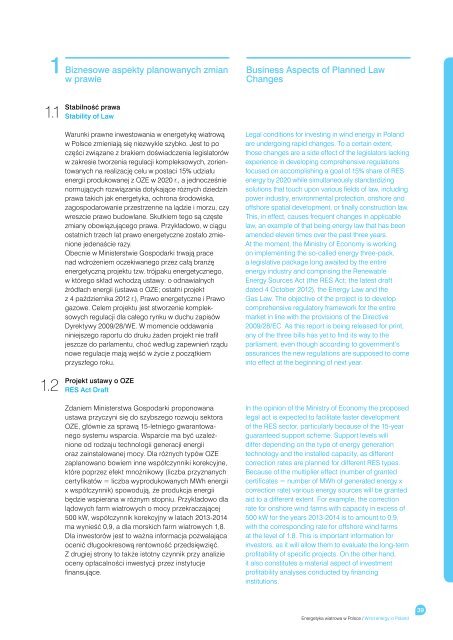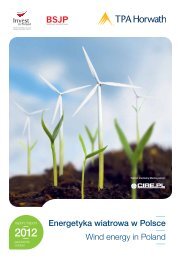Energetyka wiatrowa w Polsce Wind energy in Poland - TPA Horwath
Energetyka wiatrowa w Polsce Wind energy in Poland - TPA Horwath
Energetyka wiatrowa w Polsce Wind energy in Poland - TPA Horwath
You also want an ePaper? Increase the reach of your titles
YUMPU automatically turns print PDFs into web optimized ePapers that Google loves.
1<br />
1.1<br />
1.2<br />
Biznesowe aspekty planowanych zmian<br />
w prawie<br />
Stabilność prawa<br />
Stability of Law<br />
Warunki prawne <strong>in</strong>westowania w energetykę wiatrową<br />
w <strong>Polsce</strong> zmieniają się niezwykle szybko. Jest to po<br />
części związane z brakiem doświadczenia legislatorów<br />
w zakresie tworzenia regulacji kompleksowych, zorientowanych<br />
na realizację celu w postaci 15% udziału<br />
energii produkowanej z OZE w 2020 r., a jednocześnie<br />
normujących rozwiązania dotykające różnych dziedz<strong>in</strong><br />
prawa takich jak energetyka, ochrona środowiska,<br />
zagospodarowanie przestrzenne na lądzie i morzu, czy<br />
wreszcie prawo budowlane. Skutkiem tego są częste<br />
zmiany obowiązującego prawa. Przykładowo, w ciągu<br />
ostatnich trzech lat prawo energetyczne zostało zmienione<br />
jedenaście razy.<br />
Obecnie w M<strong>in</strong>isterstwie Gospodarki trwają prace<br />
nad wdrożeniem oczekiwanego przez całą branżę<br />
energetyczną projektu tzw. trójpaku energetycznego,<br />
w którego skład wchodzą ustawy: o odnawialnych<br />
źródłach energii (ustawa o OZE; ostatni projekt<br />
z 4 października 2012 r.), Prawo energetyczne i Prawo<br />
gazowe. Celem projektu jest stworzenie kompleksowych<br />
regulacji dla całego rynku w duchu zapisów<br />
Dyrektywy 2009/28/WE. W momencie oddawania<br />
n<strong>in</strong>iejszego raportu do druku żaden projekt nie trafił<br />
jeszcze do parlamentu, choć według zapewnień rządu<br />
nowe regulacje mają wejść w życie z początkiem<br />
przyszłego roku.<br />
Projekt ustawy o OZE<br />
RES Act Draft<br />
Zdaniem M<strong>in</strong>isterstwa Gospodarki proponowana<br />
ustawa przyczyni się do szybszego rozwoju sektora<br />
OZE, głównie za sprawą 15-letniego gwarantowanego<br />
systemu wsparcia. Wsparcie ma być uzależnione<br />
od rodzaju technologii generacji energii<br />
oraz za<strong>in</strong>stalowanej mocy. Dla różnych typów OZE<br />
zaplanowano bowiem <strong>in</strong>ne współczynniki korekcyjne,<br />
które poprzez efekt mnożnikowy (liczba przyznanych<br />
certyfikatów = liczba wyprodukowanych MWh energii<br />
x współczynnik) spowodują, że produkcja energii<br />
będzie wspierana w różnym stopniu. Przykładowo dla<br />
lądowych farm wiatrowych o mocy przekraczającej<br />
500 kW, współczynnik korekcyjny w latach 2013-2014<br />
ma wynieść 0,9, a dla morskich farm wiatrowych 1,8.<br />
Dla <strong>in</strong>westorów jest to ważna <strong>in</strong>formacja pozwalająca<br />
ocenić długookresową rentowność przedsięwzięć.<br />
Z drugiej strony to także istotny czynnik przy analizie<br />
oceny opłacalności <strong>in</strong>westycji przez <strong>in</strong>stytucje<br />
f<strong>in</strong>ansujące.<br />
Bus<strong>in</strong>ess Aspects of Planned Law<br />
Changes<br />
Legal conditions for <strong>in</strong>vest<strong>in</strong>g <strong>in</strong> w<strong>in</strong>d <strong>energy</strong> <strong>in</strong> <strong>Poland</strong><br />
are undergo<strong>in</strong>g rapid changes. To a certa<strong>in</strong> extent,<br />
those changes are a side effect of the legislators lack<strong>in</strong>g<br />
experience <strong>in</strong> develop<strong>in</strong>g comprehensive regulations<br />
focused on accomplish<strong>in</strong>g a goal of 15% share of RES<br />
<strong>energy</strong> by 2020 while simultaneously standardiz<strong>in</strong>g<br />
solutions that touch upon various fields of law, <strong>in</strong>clud<strong>in</strong>g<br />
power <strong>in</strong>dustry, environmental protection, onshore and<br />
offshore spatial development, or f<strong>in</strong>ally construction law.<br />
This, <strong>in</strong> effect, causes frequent changes <strong>in</strong> applicable<br />
law, an example of that be<strong>in</strong>g <strong>energy</strong> law that has been<br />
amended eleven times over the past three years.<br />
At the moment, the M<strong>in</strong>istry of Economy is work<strong>in</strong>g<br />
on implement<strong>in</strong>g the so-called <strong>energy</strong> three-pack,<br />
a legislative package long awaited by the entire<br />
<strong>energy</strong> <strong>in</strong>dustry and compris<strong>in</strong>g the Renewable<br />
Energy Sources Act (the RES Act; the latest draft<br />
dated 4 October 2012), the Energy Law and the<br />
Gas Law. The objective of the project is to develop<br />
comprehensive regulatory framework for the entire<br />
market <strong>in</strong> l<strong>in</strong>e with the provisions of the Directive<br />
2009/28/EC. As this report is be<strong>in</strong>g released for pr<strong>in</strong>t,<br />
any of the three bills has yet to f<strong>in</strong>d its way to the<br />
parliament, even though accord<strong>in</strong>g to government’s<br />
assurances the new regulations are supposed to come<br />
<strong>in</strong>to effect at the beg<strong>in</strong>n<strong>in</strong>g of next year.<br />
In the op<strong>in</strong>ion of the M<strong>in</strong>istry of Economy the proposed<br />
legal act is expected to facilitate faster development<br />
of the RES sector, particularly because of the 15-year<br />
guaranteed support scheme. Support levels will<br />
differ depend<strong>in</strong>g on the type of <strong>energy</strong> generation<br />
technology and the <strong>in</strong>stalled capacity, as different<br />
correction rates are planned for different RES types.<br />
Because of the multiplier effect (number of granted<br />
certificates = number of MWh of generated <strong>energy</strong> x<br />
correction rate) various <strong>energy</strong> sources will be granted<br />
aid to a different extent. For example, the correction<br />
rate for onshore w<strong>in</strong>d farms with capacity <strong>in</strong> excess of<br />
500 kW for the years 2013-2014 is to amount to 0.9,<br />
with the correspond<strong>in</strong>g rate for offshore w<strong>in</strong>d farms<br />
at the level of 1.8. This is important <strong>in</strong>formation for<br />
<strong>in</strong>vestors, as it will allow them to evaluate the long-term<br />
profitability of specific projects. On the other hand,<br />
it also constitutes a material aspect of <strong>in</strong>vestment<br />
profitability analyses conducted by f<strong>in</strong>anc<strong>in</strong>g<br />
<strong>in</strong>stitutions.<br />
<strong>Energetyka</strong> <strong>wiatrowa</strong> w <strong>Polsce</strong> / <strong>W<strong>in</strong>d</strong> <strong>energy</strong> <strong>in</strong> <strong>Poland</strong><br />
39



